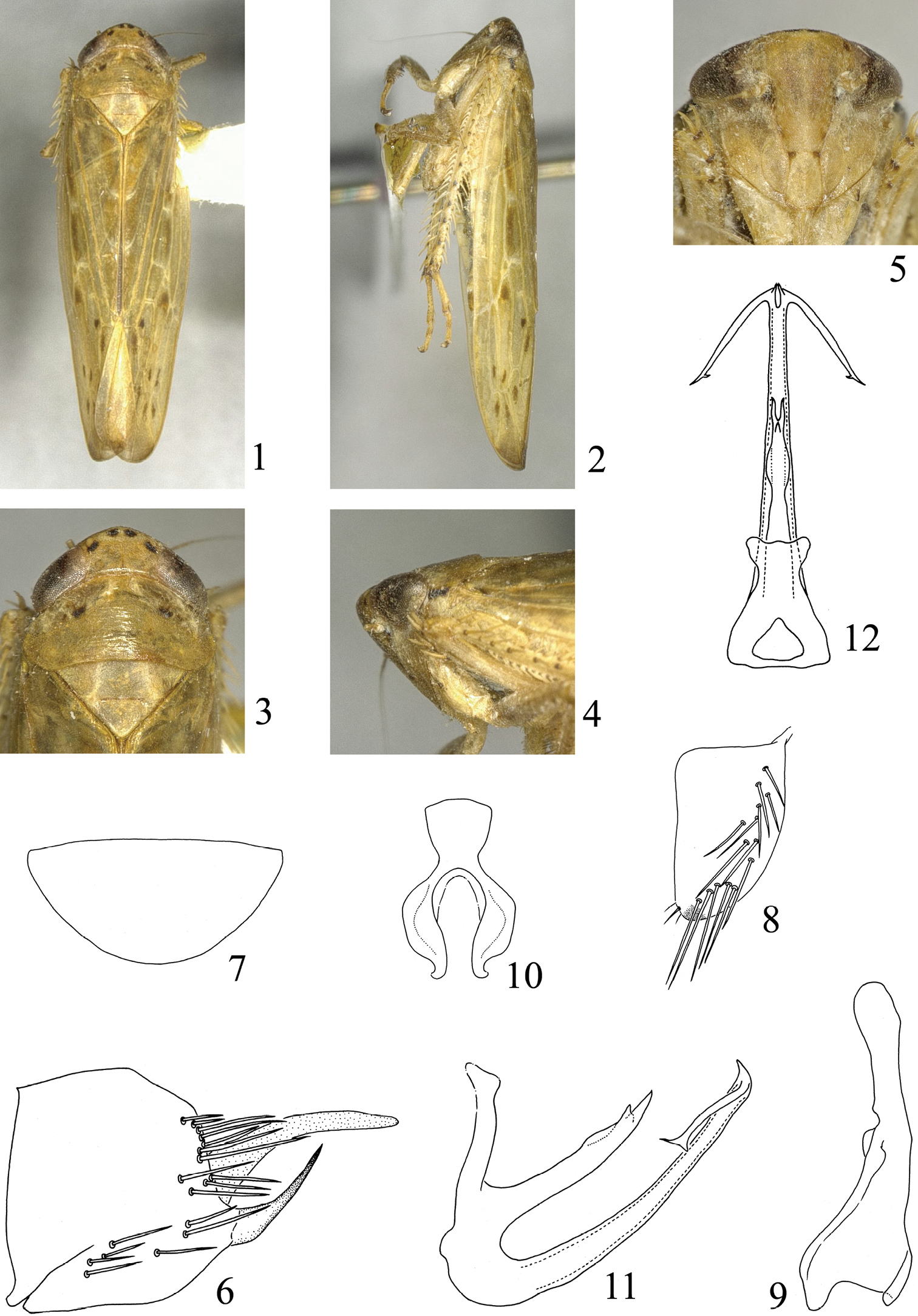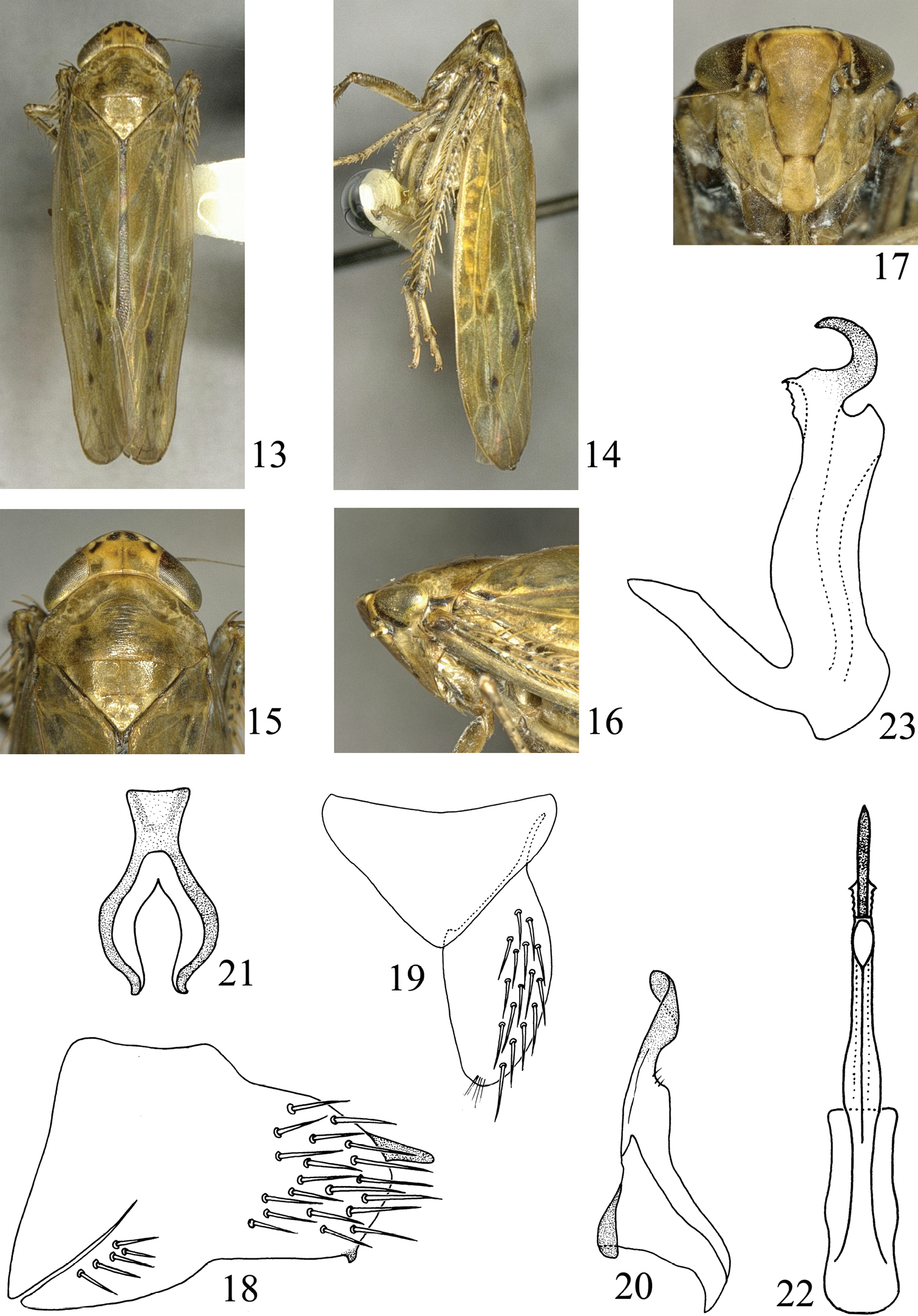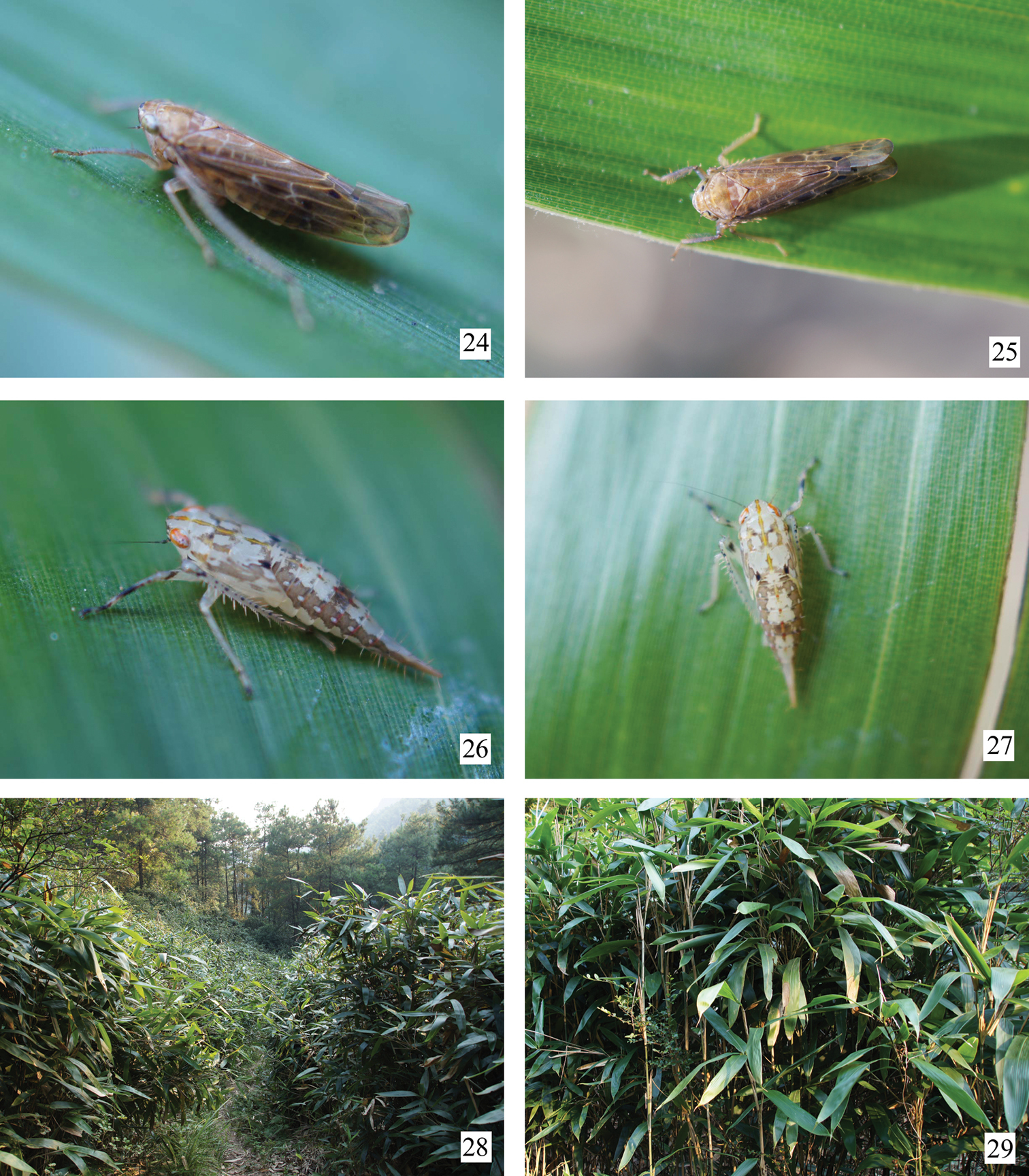






(C) 2013 Lin Yang. This is an open access article distributed under the terms of the Creative Commons Attribution License 3.0 (CC-BY), which permits unrestricted use, distribution, and reproduction in any medium, provided the original author and source are credited.
For reference, use of the paginated PDF or printed version of this article is recommended.
Citation: Yang L, Chen X-S (2013) Two new species of the bamboo-feeding leafhopper genus Abrus Dai & Zhang (Hemiptera, Cicadellidae, Deltocephalinae) from China. ZooKeys 318: 81–89. doi: 10.3897/zookeys.318.5799
Two new species of the bamboo-feeding genus Abrus Dai & Zhang, 2002, Abrus xishuiensis sp. n. and Abrus langshanensis sp. n., are described and illustrated from Guizhou and Hunan, South China. A checklist and a key to 13 known species are given.
Bamboo leafhopper, Cicadomorpha, distribution, Homoptera, taxonomy
The bamboo-feeding leafhopper genus Abrus was established by
During on-going studies on species biodiversity of the bamboo-feeding leafhoppers in China, some specimens belonging to undescribed species of the genus Abrus were found. The purpose of this paper is to describe two new species and to provide an identification key to the known species of Abrus.
In the present paper, terminology follows
http://species-id.net/wiki/Abrus
Abrus hengshanensis Dai & Zhang, 2002, by original designation.
For the diagnosis and relationships of Abrus see
China (Gansu, Hunan, Fujian, Guizhou, Guangxi and Guangdong).
Abrus bifurcatus:
Abrus biprocessus:
Abrus breviolus:
Abrus brevis:
Abrus concavelus:
Abrus coneus:
Abrus graciaedeagus:
Abrus hengshanensis:
Abrus huangi:
Abrus leigongshanensis:
Abrus langshanensis sp. n.; China (Hunan).
Abrus wuyiensis:
Abrus xishuiensis sp. n.; China (Guizhou).
(Modified from
| 1 | Basal projection of aedeagal shaft shorter than half length of shaft, reduced or absent (Fig. 23) | 2 |
| – | Basal projection of aedeagal shaft equal to or longer than half length of shaft (Fig. 11) | 3 |
| 2 | Subgenital plate short, with posterior margin truncate | Abrus breviolus |
| – | Subgenital plate moderately long, with posterior margin rounded (Fig. 19) | Abrus langshanensis sp. n. |
| 3 | Aedeagal shaft about half length of basal projection, apical appendages extended posterad | Abrus brevis |
| – | Aedeagal shaft as long as or longer than basal projection, apical appendages extended basolaterad (Figs 11, 12) | 4 |
| 4 | Pygofer with one long process at each posterodorsal margin | Abrus wuyiensis |
| – | Pygofer without processes at posterodorsal margin (Fig. 6) | 5 |
| 5 | Pygofer with one pair of processes at each posteroventral margin | Abrus biprocessus |
| – | Pygofer with one process or without processes at each posteroventral margin | 6 |
| 6 | Apical appendages of aedeagus branched at apex (Figs 11, 12) | 7 |
| – | Apical appendages of aedeagus not branched at apex | 10 |
| 7 | Apical appendages of aedeagus with small process at base | 8 |
| – | Apical appendages of aedeagus without process at base (Figs 11, 12) | Abrus xishuiensis sp. n. |
| 8 | Pygofer with long process at posteroventral corner; basal projection of aedeagus short, about half length of shaft Abrus coneus | |
| – | Pygofer without long process at posteroventral corner, basal projection of aedeagus as long as shaft | 9 |
| 9 | Basal projection of aedeagus with pair of triangular appendages laterally at midlength, aedeagal shaft without ventral flange at apex Abrus bifurcatus | |
| – | Basal projection of aedeagus without appendage laterally at midlength, aedeagal shaft with ventral triangular flange at apex | Abrus concavelus |
| 10 | Pygofer without process at ventral margin | 11 |
| – | Pygofer with process at ventral margin | 12 |
| 11 | Apical appendages of aedeagus directed dorsally, basal projection of aedeagus without lateral appendages in ventral view | Abrus leigongshanensis |
| – | Apical appendages of aedeagus directed lateroventrally, basal projection of aedeagus with lateral appendages in ventral view | Abrus graciaedeagus |
| 12 | Pygofer with process at caudoventral margin; basal projection of aedeagus dentate along ventral margin and with lateral appendages directed ventrally | Abrus huangi |
| – | Pygofer with digitate process in the middle of ventral margin; basal projection of aedeagus with a long process subapically and lateral appendages directed dorsally | Abrus hengshanensis |
urn:lsid:zoobank.org:act:236C1818-2ED6-4197-953E-F64BE108CEF1
http://species-id.net/wiki/Abrus_xishuiensis
Figs 1–12Holotype: ♂, China: Guizhou, Xishui, Changqiangou (106°12'E, 28°19'N), 700m, on bamboo, 29 Sep. 2000, X.-S. Chen; paratypes: 3 ♂♂, 3 ♀♀, same data as holotype.
The species is named after the type locality, Xishui, Guizhou Province in China.
Body length including forewing male 9.02–9.25 mm (N = 4), female 9.35–9.90 mm (N = 3); forewing length male 7.62–8.10 mm (N = 4), female 8.00–8.40 mm (N = 6).
Orange to yellowish brown (Figs 1–5). Crown with two pairs of similar blackish brown spots on anterior margin, along suture pale reddish orange. Eyes blackish brown, anterior angle pale reddish brown. Pronotum with pair blackish brown spots on anterior part, with short pale reddish orange stripe centrally. Scutellum with reddish orange marking centrally, transverse suture pale reddish orange. Inner and central anteapical cells at apex, third and fourth apical cells at base each with a dark brown spot.
Abrus xishuiensis sp. n. 1 Male habitus, dorsal view 2 Same, lateral view 3 Head and thorax, dorsal view 4 Same, lateral view 5 Face 6 Pygofer, lateral view 7 Valve 8 Subgenital plate 9 Style 10 Connective 11 Aedeagus, lateral view 12 Same, posteroventral view.
Crown length 0.7× medial width between eyes. Pronotum length 1.93× medial length of crown. Scutellum length 0.93× medial length of pronotum. Forewing length 3.87× medial width at widest part.
Pygofer (Fig. 6) trapeziform in shape, with macrosetae along posterior margin and midventrally; posterior margin truncate; posteroventral process broad at base, acute apically, slightly curved dorsad, directed posterodorsad; membranous process at inner apex, slightly curved ventrally, broad at base, acute apically, apex acute. Genital valve (Fig. 7) broad triangular, posterior margin rounded, basal width 2.02× median length. Subgenital plate (Fig. 8) broad and short; outer margin rounded; with many macrosetae on lateral region. Style (Fig. 9) long; broad at base; narrow at middle; apex slightly widening; apical margin rounded. Connective (Fig. 10) Y-shaped, shaft robust, arms well developed, shaft length 0.65× length of arm. Aedeagus (Figs 11, 12) with developed basal projection dorsally, about 2/3 length of aedeagal shaft; apex branched in dorsal view; dorsal margin with a stout tooth subapically, grooved at apical third; aedeagal shaft in profile (Fig. 11) slightly curved dorsad, slender, long, tapering apically; dorsal margin of apex with pair small processes, beak-like, directed dorsally; shaft with pair of lateral appendages subapically, each with apex branched. Phallotreme apical on ventral surface.
Bamboo (Chimonobambusa angustifolia C. D. Chu & C. S. Chao).
Southwest China (Guizhou).
This species resembles Abrus biprocessus Li, 2011 in appearance, but can be distinguished by body size ♂ 9.02–9.25 mm, ♀ 9.35–9.90 mm (♂ 8.1 mm, ♀ 8.2 mm in biprocessus); pygofer with one process at posteroventral corner (with two processes in biprocessus); basal projection of aedeagus with apical appendages stout and short (slender and long in biprocessus); subapical appendages of aedeagal shaft branched at apex, without a small branch basally (not branched at apex, with a small branch at basal third in biprocessus).
urn:lsid:zoobank.org:act:EDFF6A6F-7337-4AAE-915F-FB2631FDE451
http://species-id.net/wiki/Abrus_langshanensis
Figs 13–27Holotype: ♂, China: Hunan, Xinning, Langshan (110°49'E, 26°22'N), on bamboo, Indocalamus sp., 6 Oct. 2010, X.-S. Chen and L. Yang; paratypes 1 ♂, 1 ♀, data same as holotype; paratype 1 ♂, Hunan, Xinning, Langshan, on bamboo, Indocalamus sp., 2 Oct. 2011, X.-S. Chen and L. Yang.
This species is named after the type locality, Langshan, Xinning, Hunan Province in China.
Body length including forewing male 9.10–9.60 mm (N = 3), female 9.55 mm (N = 1); forewing length male 7.70–8.10 mm (N = 3), female 7.85 mm (N = 1).
General color pale yellowish orange (Figs 13–17). Crown with two pairs of similar blackish brown spots on anterior margin. Eyes blackish brown, ocelli pale yellowish white. Face pale yellowish white. Inner and central anteapical cells at apex, third and fourth apical cells at base each with a dark brown spot.
Abrus langshanensis sp. n. 13 Male habitus, dorsal view 14 Same, lateral view 15 Head and thorax, dorsal view 16 Same, lateral view 17 Face 18 Pygofer, lateral view 19 Valve and subgenital plate 20 Style 21 Connective 22 Aedeagus, posteroventral view 23 Same, lateral view.
Crown medial length 0.58× width between eyes. Pronotum length 2.03× medial length of crown. Scutellum length 0.87× medial length of pronotum. Forewing length 4.00× medial width at widest part.
Pygofer in lateral view (Fig. 18) narrower posteriorly; covered with macrosetae posteriorly, with several basoventrally dorsad of ventral margin; dorsal margin sinuate; ventral margin concave medially; with a small papillae posteriorly. Genital valve (Fig. 19) broad triangular; posterior margin slightly acute and rounded; basal width 1.95× medial length. Subgenital plate (Fig. 19) broad and short; outer margin roundedly curved; with many macrosetae on lateral region. Style (Fig. 20) long; broad at base; narrowing apically; apex slightly recurved; apical margin acute and rounded. Connective (Fig. 21) Y-shaped; stem robust; arms well developed; length of stem 0.44× that of arm. Aedeagus (Figs 22, 23) without basal projection dorsally; aedeagal shaft in lateral view (Fig. 23) almost S-shaped; apex produced into a robust hook-like process. Phallotreme apical on ventral surface.
Bamboo (Indocalamus sp.).
Abrus langshanensis sp. n. and its host plant. 24, 25 Adult resting on leaf of bamboo 26, 27 Nymph resting on leaf of bamboo 28 View of the area where Abrus langshanensis were captured, in Langshan, Xinning, Hunan, with Indocalamus sp. 29 View of the plant. Photograph by X.-S. Chen.
South China (Hunan).
This new species is similar to Abrus breviolus Dai & Zhang, 2008 in aedeagus having reduced or small basal projection dorsally, but can be distinguished by posterior margin of male pygofer without process (with stout process dorsally in breviolus); apical margin of subgenital plate rounded (truncate in breviolus); aedeagal shaft with apex hook-like, without pair of subapical appendages (with pair of subapical appendages laterally in breviolus).
We are grateful to Dr. Ji-Chun Xing (Institute of Entomology, Guizhou University, China) for preparing figures of Abrus langshanensis. We also thank Dr. Guang-Qian Gou (College of Life Science, Guizhou University, China) for identifying bamboo species. This research was supported by the National Natural Science Foundation of China (No. 30560020, 31160163, 31260178), China Postdoctoral Science Foundation (No. 2005037111), and the International Science and Technology Cooperation Program of Guizhou (20107005).


